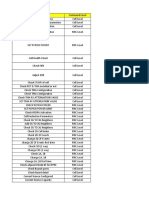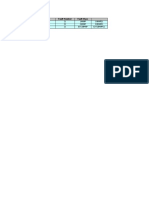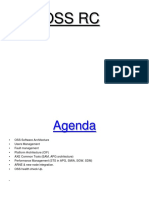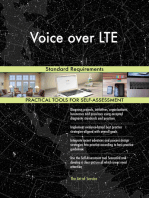RET Antennas System: For Antenna Sharing
RET Antennas System: For Antenna Sharing
Uploaded by
samiahosniCopyright:
Available Formats
RET Antennas System: For Antenna Sharing
RET Antennas System: For Antenna Sharing
Uploaded by
samiahosniOriginal Description:
Original Title
Copyright
Available Formats
Share this document
Did you find this document useful?
Is this content inappropriate?
Copyright:
Available Formats
RET Antennas System: For Antenna Sharing
RET Antennas System: For Antenna Sharing
Uploaded by
samiahosniCopyright:
Available Formats
RET Antennas System
Remote Control Units
Dual version of our MDCU module for the remote control of the electrical downtilt on SLIMLINE and TWINLINE antennas. Two independent inputs for antenna sharing with separate control from two different RET controllers / NodeB Capable of different protocols: AISG 1.1, 3GPP/AISG 2.0, Ericsson No extra protruding at the antenna bottom. Easy to install thanks to the captive screws.
MDDU module
for antenna sharing
The MDDU (Multiple Devices Dual Unit) is a unit that allows two separate RET Controllers to drive independently the RETs in antennas with factory installed motors. An MDDU is mainly equivalent to two MDCUs connected to all the motors. It has a size similar to an MDCU and can be installed in place of an MDCU in an antenna. The module has two AISG male connectors (one per internal MDCU) to provide the two independent control accesses. Each internal MDCU is called A or B sub-unit according to the photo below.
DT 5544 - Ed C- page 1/3 - We reserve the rights to modify our products without prior notice. - Several patents pending regarding this product
Triple band RET antenna type 5880000 with MDDU fitted in it
Independently of the other sub-unit, each internal sub-unit can be factory set to any protocol, can be factory set to drive any quantity of the internal motors, and can run its protocol without interfering with the other sub-unit. Two motors cannot move at the same time. If one RET Controller has sent a Set Tilt command or a Calibrate command, then the other RET Controller will receive a Busy response if it tries to one of these actions. It will have to wait for the completion of the motor move before it can obtain its own motor move. When an MDDU module is installed in an antenna, all the tilt indicators remain visible, and manual change of the tilt is still possible (manual override, the controller will read the new tilt setting).
Technical Data
Input control port Daisy chain port Power supply Two male AISG 8 pin connectors (type IEC60130-9 Ed 3.0) for control data and power supply of each internal sub-unit. None (daisy chain of RET units by external splitter) For each half internal unit: +12V (pin1) or +24V (pin 6) DC. If both voltages are supplied, the unit is powered by the 24V line. Compatible with 10V30V on pin 6 and on pin 1. Stand-by: 0.5 W per half internal unit During tilt change: 4 W typical / 10 W max. RS485 / 9.6 kbps for AISG, 115 kbps for Ericsson protocol HDLC (level 2) and commands/responses (level 7) as per AISG 1.1 or AISG 2.0/3GPP or Ericsson protocol (depending on the part number of the device). Software upgrade by the download functionality is implemented in AISG protocols. Typically less than 15 seconds (may depend on antenna type and outdoor temperature) +/-0.5 50 000 minimum
Power consumption Data lines / data rate Control protocol
Tilt change duration Precision Tilt change capability
w w w. a m p h e n o l -a n t e n n a s . co m
RET Antennas System
Remote Control Units
MDDU module
Dimensions (approx) Weight Temperature range IP rating Installation Depth: 106 mm (only 31 mm outside the antenna) excluding connectors Width:80 mm Height: 25 mm 400 g approx. -40C to +60C operating with tilt change (motor operation), no icing -40C to +70C operating stand-by (no motor actuation) or storage. The unit is a plug-in module that is installed inside the antenna. There is no specific IP rating that applies to it. The unit is fitted inside the antenna and secured with captive screws. Before inserting the unit inside the antenna, there is no need of prior positioning of either the unit or the antenna tilt mechanism to a dedicated position. A spare or retrofit unit will need to be loaded with configuration data unless it is ordered as factory set to a specified antenna type.
Part numbering
An MDDU can be factory set in a lot of different ways due to the parameters setting of the A and B internal sub-units. The MDDU part number is built as follows:
MDDU-pAx x pBy y
DT 5544 - Ed C- page 2/3 - We reserve the rights to modify our products without prior notice. - Several patents pending regarding this product
Sub-unit B: One capital letter (for protocol) and two digits (for parameter settings) Sub-unit A: One capital letter (for protocol) and two digits (for parameter settings)
Coding of the protocol: The letters p and p code the protocol to which the A or B sub-unit is set at time of shipment:
A B
G A E
3GPP / AISG 2.0 protocol (with RETs responding as 3GPP single-antenna devices) AISG 1.1 protocol Ericsson proprietary protocol
Note: The 3GPP/AISG 2.0 protocol with RET units responding as a 3GPP multi-antenna device is not yet implemented.
Coding of the parameters setting: The pair of digits xx and yy are used to code the parameter settings of the A and B sub-units. This correspond to the antenna RET motors that will be driven by each sub-unit. There is no specific coding way and a new combination is allocated when it is needed. The table below shows some typical codes already allocated. Allocated MDDU part numbers: Because of the various setting possibilities, there are a lot of MDDU part numbers that are already allocated consult us for detailed description of any particular MDDU code. The table below indicates the basic MDDU part numbers: MDDU-G00G00 MDDU-G02G01 Both A and B sub-units control all the internal motors of the antenna For TWIN single-band antennas: Sub-unit A: control the motor on the RIGHT side of the antenna Sub-unit B: control the motor on the LEFT side of the antenna For TWIN dual-band antennas: Sub-unit A: control all the motors on the RIGHT side of the antenna Sub-unit B: control all the motors on the LEFT side of the antenna For TWIN triple-band antennas: Sub-unit A: control all the motors on the RIGHT side of the antenna Sub-unit B: control all the motors on the LEFT side of the antenna
MDDU-G10G12
MDDU-G20G22
Replace G by A for AISG 1.1 protocol. Consult us for Ericsson specific protocol. Additional coding values will be defined when necessary. Please contact us for uncovered needs.
w w w. a m p h e n o l -a n t e n n a s . co m
RET Antennas System
Remote Control Units
MDDU module
"RET-Ready" Antennas
Thanks to its small size and its installation inside the antenna, we can deliver antennas with the MDDU already installed and pre-commissioned to fit all antenna parameters. Every RET device is factory configured and calibrated, and informative data like antenna model number and serial number is factory loaded. So the antenna is ready to be used once delivered to the site. There is no need for further installation of the RET devices nor for programming their configuration and for running a calibration process. This is what we call "RET-Ready" Antennas In addition, each RET ID (serial number) will use its first (most left) character to indicate the colour of the corresponding frequency band of the antenna. This greatly helps during site commissioning by the ease it provides to distinguish between the RET devices shown by the AISG controller in the device list.
Note: When delivered as spare or retrofit units, an MDDU will have a letter Z instead of the colour coding letter as the first (most left) character of all its RET ID (serial number). configuration file before any first operation. Please keep in mind that with the Ericsson protocol it is not possible to send a configuration file to the RET unit; so the MDDU has to be factory set to an antenna type before delivery. DT 5544 - Ed C- page 3/3 - We reserve the rights to modify our products without prior notice. - Several patents pending regarding this product Such spare or retrofit units will also not be configured to any antenna unless the purchase order specifically asks for it. It will need the usual upload of a
"RET Ready" Antenna Part numbers We have specific part numbers for antennas delivered with the MDDU already installed in it. Please contact us for more information.
w w w. a m p h e n o l -a n t e n n a s . co m
You might also like
- Wireless Management System Small Cells TrainingNo ratings yetWireless Management System Small Cells Training45 pages
- Kathrein'S Remote Electrical Tilt System: Overview of Related Products, Installation and Control Possibilities100% (1)Kathrein'S Remote Electrical Tilt System: Overview of Related Products, Installation and Control Possibilities20 pages
- Understanding and Troubleshooting 4G Alarms100% (1)Understanding and Troubleshooting 4G Alarms22 pages
- Ethio Telecom TSSR Template Power 132139No ratings yetEthio Telecom TSSR Template Power 1321396 pages
- How Many Channels Are Present in GSM 900?No ratings yetHow Many Channels Are Present in GSM 900?2 pages
- LTE Drop Call PS Problem Caused by X2 State in Ericsson - v1100% (1)LTE Drop Call PS Problem Caused by X2 State in Ericsson - v12 pages
- MIMO Andmimo Smart Antennas - July 2013 - FINALNo ratings yetMIMO Andmimo Smart Antennas - July 2013 - FINAL42 pages
- CS Voice Precise Power Control (RAN19.1 - 01)100% (1)CS Voice Precise Power Control (RAN19.1 - 01)41 pages
- 7778 Wcdma Bts Dedicated Measurement FailureNo ratings yet7778 Wcdma Bts Dedicated Measurement Failure2 pages
- SMART UNO/Refarm RET Cabling & Naming Convention: (Needs Site Testing and Verification Before Taken in Use!)No ratings yetSMART UNO/Refarm RET Cabling & Naming Convention: (Needs Site Testing and Verification Before Taken in Use!)19 pages
- Huawei DBS3900 LTE Network Commissioning v1.1No ratings yetHuawei DBS3900 LTE Network Commissioning v1.177 pages
- Radio Network Planning and Optimisation for UMTSFrom EverandRadio Network Planning and Optimisation for UMTSJaana Laiho4.5/5 (2)



























































